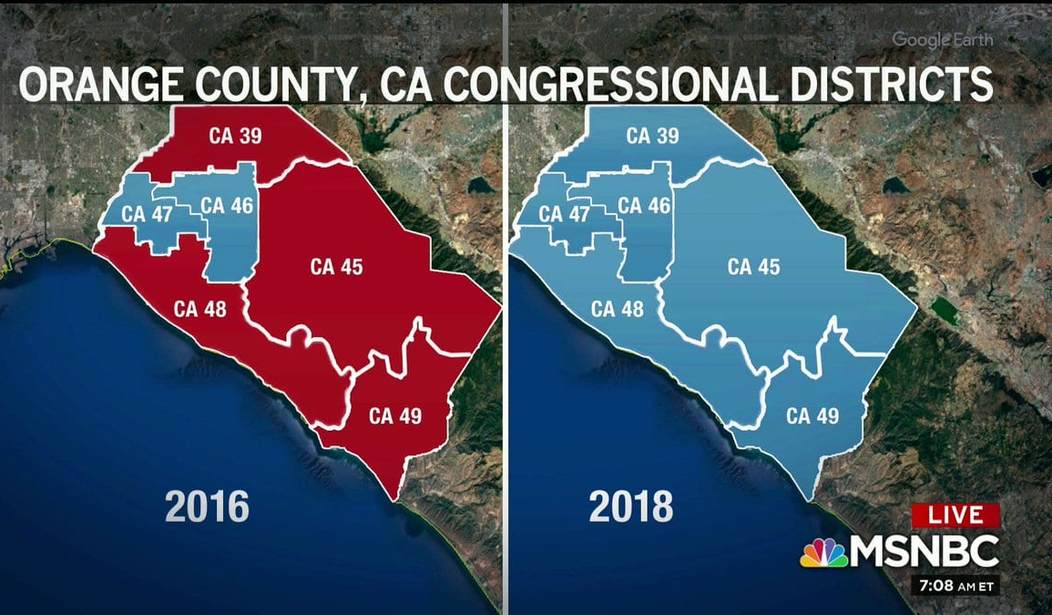One of the most shocking results of the 2018 “Blue Wave” election was the complete flip of Orange County, California. For the state’s Republicans, Orange County represented safety and sanity, but no more.
In 2016, the conservative bastion of Orange County, California, voted for a Democratic presidential candidate for the first time since the Great Depression. Two years later, Democrats succeeded in capturing all seven of its congressional seats ― a stunning feat in what has traditionally been a seat of Republican power that catapulted both Richard Nixon and Ronald Reagan to the White House.
The visual representation brings tears to one’s eyes.
Congressional districts in Orange County, Calif. in 2016 and in 2018 pic.twitter.com/TWRQ1pPzS4
— Morning Joe (@Morning_Joe) November 16, 2018
It was a stunning failure by the state and county Republican parties, who claimed to have given everything they had to help these candidates.
An examination of the Republican Party of Orange County’s finances (both contributions received and made) reveals a pattern eerily similar to what happened in neighboring Los Angeles County, as was reported on in Feburary.
In the waning days of the election over $500,000 came in to the party from a group of incumbent legislators and PACs connected to those legislators and nearly the same amount went out to just five candidates, none of whom were running in Orange County.
Under California law, county and state parties can make unlimited contributions to individual candidates, while campaign committees, individuals, and PACs are subject to contribution limits. Campaign committees can give up to $36,500 to a county or state party, and PACs that aren’t formed to support a state candidate can give to county or state parties with no limit.

It’s not unheard of for candidates who are strong fundraisers or long-time officeholders (with big campaign accounts) to give to their county party, so the county can make expenditures (such as get-out-the-vote programs and mailers) to help all of the candidates. What is not allowed is making contributions to the county or state party with the understanding that those contributions will then be funneled to particular candidates, since that would be done with the intent to circumvent campaign contribution limits.
With that in mind, consider the following (maximum) contributions from a number of legislators and PACs, many of whom (coincidentally?) made contributions to the Los Angeles county party (RPLAC) on the same dates. These contributions total $531,500.
- $36,500 from Asm. Chad Mayes (Riverside/San Bernardino County), 8/23/18 and 9/23/18*
- $36,500 from Asm. Marie Waldron (San Diego County), 10/4/18*
- $36,500 from Sen. Brian Jones (San Diego County),
- $36,000 from New Majority PAC, 10/19/18
- $36,500 from Friends of Frank Bigelow (Madera County), 7/9/18*
- $36,500 from Asm. Brian Dahle (Lassen County), 9/14/18*
- $36,500 from Asm. Jim Nielsen (Fresno County), 10/2/18
- $36,500 from Asm. James Gallagher (Sutter County), 9/24/18*
- $20,000 from Sen. Scott Wilk (Los Angeles County), 10/2/18
- $40,000 from the Lincoln Club of Orange County, 10/16/18 and 10/20/18
- $36,500 from Andreas Borgeas (Fresno County candidate for CA Senate), 10/2/18
- $36,500 from Sen. Pat Bates (Orange/Riverside County), 9/25/18, 10/3/18, 10/29/18
Asm. Frank Bigelow’s “Friends of Frank Bigelow” account still had over $700,000 on hand at the end of the cycle – a massive amount for a farmer from Fresno – which was transferred into the legislator’s 2020 account.
An interesting connection between Orange County and Los Angeles County is the influence of New Majority PAC and its Executive Director, Andy Gharakhani. Gharakhani served as Finance Director of the Republican Party of Los Angeles County and pocketed $30,000 in “consulting fees” during the 2018 cycle, but abruptly resigned his post a week ago. Many of the officeholders/candidates who sent maximum contributions to RPOC are also involved with New Majority, which is based in Orange County and contributed $36,000 to RPOC.
If all of this funding was used to purchase media time or run get-out-the-vote programs for embattled candidates, it would be understandable that these politicians, who are all in leadership positions in the Assembly, poured dollars into the party. But $517,000 of that $531,500 went to just five candidates, again, none of whom were running in Orange County. Only one candidate, Jordan Cunningham, won.
- $92,000 to Rob Poythress, a candidate for State Senate from Madera
- $295,000 to Bill Essayli, a candidate for State Assembly from Riverside
- $50,000 to Dante Acosta, Assemblyman from Santa Clarita
- $40,000 to Andy Vidak, State Senator from Hanford
- $25,000 Jordan Cunningham, Assemblyman from San Luis Obispo
Four of the five candidates (Poythress, Essayli, Acosta, and Cunningham) also received huge contributions from RPLAC. And, in addition to contributing $92,000 in cash to Poythress, the Orange County GOP reported $200,000 in non-monetary contributions to the failed candidate.
Imagine what that cash could have done to preserve seats in Congress, in the California Legislature, and at the local level?
What is going on here? To date, no one has produced a “smoking gun” memo or email or text message laying out a scheme. The circumstantial evidence is extremely concerning, though, and Orange County Republicans should be asking their leaders what happened before the bloodbath continues in 2020.













Join the conversation as a VIP Member